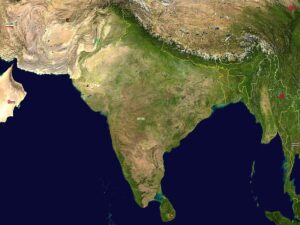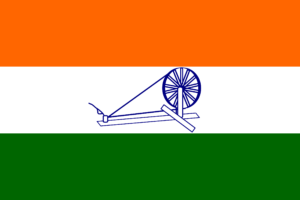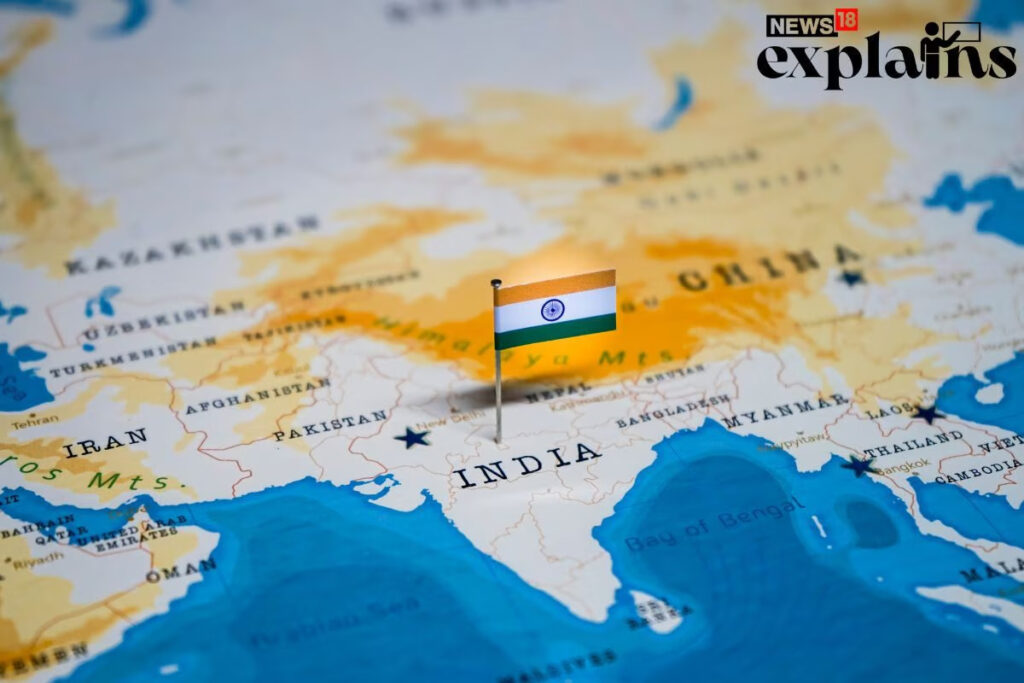Executive Summary: The intent of this paper is to highlight the need for the reincarnation of Bharatvarsha by way of change in name, a return to Dharmic governance, providing every person of Dharmic faith unrestricted rights to travel to and from, and offering refuge to minorities from Pakistan, Afghanistan, and Bangladesh.

Background: The Bharatiya Subcontinent has been referred to as Jambudvipa in ancient Dharmic texts. In places like Cambodia, Vietnam, Thailand, and Bali, that name is still used.
The word Hindustan was popularized by Arabs and Persians who went to India for trade, military conquest, and religious expansion.
It is important to note that Jambudvipa, Bharatvarsha, Hindustan and India were all names of a region. Bharatvarsha was a set of numerous independent states.
After the Islamic invasion of the subcontinent, the region was referred to as Hindustan by Muslims and Urdu speaking Dharmics. This is still the case.
The name India was used and popularised by the European invaders and remains in place as the first of the two official names, the second being Bharat.
Why Change the Name? There are several reasons for this, but the first is – most of India’s population, which lives in villages and is the true representation of the country, refer to their nation as “Bharat”. This is so in almost all states and considering the dozens of different official languages and unofficial dialects.
The second reason is historic, but also ties in with national identity and pride. The martyrdom of freedom fighters such as Guru Govind Singh Ji, Maharani Laxmi Bai, Chandra Shekhar Azad Ji and countless others, who died shouting the slogan “Bharat Mata Ki Jai” should serve as an everlasting beacon of pride.
When people assume an identity that is not their own, any sense of identity or pride will only be superficial. Could this be the reason for the hordes of Indians lined up at the embassies in Chanakya Puri, New Delhi? Even at the Embassies of other developing nations.
Even a country like Kuwait where the display of non-Abrahamic symbols is banned, attracts hoards Dharmic immigrants. The wearing of an Om or Khanda pendant will invite severe punishment. There is not a single Hindu, Sikh, Jain, or Buddhist temple in Kuwait. Not even a crematorium. For the last rites, the bodies of Dharmic people are sent back to their country of origin. The Indian Ministry of External affairs had pushed for the establishment of a crematorium, but that request was denied by the Government of Kuwait.
Surely a correlation can be made with the lack of pride and the fake identity of nationhood that India currently has. But will changing the name the end solution? No, this will only be scratching the surface. A wholesome solution will be an overhaul and re-incarnation of Bharatvarsha, a Union of States, the Hindu Nation which is represented by the Bhagwa Dhwaj and governed on a Dharmic Constitution and Dharmic Penal Code or Dharmic Dand Sanhita.

A New Flag: The national flag of India, known as the Tricolour was designed by Pengali Venkayya, a supporter of the Indian National Congress (INC). One of the suggested templates included a charkha, inspired by Mohandas Gandhi’s endorsement of khadi. Although, the wheel in the Tricolour is supposed to represent the Dharma Chakra, the resemblance to the original INC inspired design is too strong to ignore. Green is supposed to represent fertility and saffron renunciation. (Ministry of Home Affairs, Flag Code of India 2002, P – 2).
Growing up in India, my teachers told me that saffron represents Dharmic religions. Islam is portrayed by green. White purity, and peace between Islamics and Dharmics. Maybe my teachers were wrong, but this is the opinion of most people I have spoken with as research for this essay.
Thus, we are left us with a national flag that serves as a propaganda tool for one political party, which is seen by most Indians as a means of appeasement and disregards thousands of years of native history. The solution – a simple saffron flag. The same flag that Maryada Purushottam Bhagwan Shri Ram used during the Lanka Campaign, the same flag used in Mahabharat, and the same flag used by the freedom fighters. Can there be a more compelling argument? Even Gandhi dreamed of “Ram Rajya”, so there can’t be a more apt representation of a Dharmic country.
To play Devil’s Advocate and say that this goes against secular principles – the national flags of Finland, Sweden, France, Great Britain, etc are inspired by Christianity. The flags of Nepal and Cambodia are rooted in Dharma. Both countries have a sizable population of Abrahamic religions. The flags of Pakistan, Bangladesh and the Islamic countries in the Middle East represent their religion. The flag of Israel is Jewish. So, what is wrong if India has a Dharmic flag?
Dharmic Governance: Why write a new constitution? Does re-inventing the wheel serve a purpose? No. But abandoning a colonial legacy, that is plagued with divisive ideology is in the best interest of every Bharatiya.
This will be a mammoth task, but the talent required to execute this is abundantly available. Bharat Sarkar and her state governments can tap into their pool of retired employees. Teams of former employees could be made for each department. These bhootpurwa employees have a thorough understanding of their own departments. Therefore, amending policies, Standard Operating Procedures, etc can be done effortlessly. These would eventually be funnelled back to Kendriya Sarkar, for indexing and including into the new Bharatiya Constitution.
What about the Minorities? Muslims make roughly 14% of the population, so it is fair to discuss them first. According to Islamic scholars, their religion originated in the Middle East and spread outwards.
Like India, Islam was brought to Spain, so that country can we used as an example. Spain was originally a collection of Catholic and some Islamic kingdoms. The Islamic influence on the local demographic has been tremendous. Today, Spain is only about 57% Catholic. Despite the reduced number, they still identify as a Catholic nation. During the Islamic conquest there were wars with the Christian kings, but today Muslims live in peace and are free to follow their religion. There exists no discrimination to non-Catholics. This is as it should be. Bharat too was a set of princely states – most of which were Dharmic and some Islamic.
To prove, that even the smallest number of minority groups will be protected by a Dharmic country, let us look at a relatively unknown segment of the Indian Muslim community – the Siddis or Habshis.
These were part of an African community that were brought to India as slaves by Arabs in the early 600 AD. Several of them escaped from their captors once landing in India. Today they are a thriving community with majority of them Islamic. This was not a rich and influential community, and yet they flourished in Bharat. The credit for this is only because of the Vedic ideals of live and let-live.
So the matter of victimization of the Muslims by the State of Bharat – can only be an imaginary concept. Over 1000 years of evidence suggests a balance of probability in their favour.
The number of Christians in India is approximately 26 million – roughly ten times the population of Rome. Like Islam, Christianity has flourished in India. Often at the cost of dilution of the local languages and culture, but that is a separate topic. Muslims and Christians enjoy minority status as per federal law, making them eligible for government assistance programs and funding. Federal Acts also hold the Government of Indian responsible for protecting minorities and helping them preserve their culture. Suffice to say – they are well protected. (US Department of State, Religious Freedom Report – India, 2022, P. 8).
Now the third of the Abrahamic faiths, the Jewish people. It is believed that the first Jews came to Bharat during the time of King Solomon (around 3000 years ago). Documentary proof exists that a Jewish community has been native of the Malabar Coast since the 9th century CE. (Yedael Y. Waldman et al, 2016).
The strong contributions of Jewish Bharatiyas translates into robust bilateral relations with Israel. Bharat Sarkar recognized the State of Israel in 1950. (Government of India, Ministry of External Affairs, 2019, P. 1).
In the 3000-year history of Hindu-Jewish relations, the only attack on Jews on Indian soil was the Mumbai terror attack of 2008 – organized and funded by Pakistan based radical organizations. (Munir Ahmed & Asim Tanvir, 2022). In an interview with ANI News on 31 January 2023, the Israeli Ambassador to India, the Honourable Naor Gillon said – “Antisemitism is not even a word that is known in India”.
Now, to collectively address the other Dharmic faiths – Sikhs, Jains, Buddhists, and countess other sub denominations. These are all religions cut from the same cloth. The divisions, if any, are all recent and due to a small group of people with vested interests.
A Refuge for Persecuted Minorities: The atrocities faced by the people of Dharmic faith in Pakistan, Afghanistan and Bangladesh is well documented.
Pakistan’s “blasphemy law” gives free reign to organizations such as Tehreek-e-Labbaik to persecute minorities, including Muslims such as the Ahmadis. On 3 December 2021, Priyantha Kumara Diyawadanage, a Buddhist from Sri Lanka was burnt alive by a mob on a busy street in Sialkot. (International Commission for Human Rights and Religious Freedom, 2021). The US Government’s 2022 Report on International Religious Freedom in Pakistan is full of instances where minorities were lynched based on romours of blasphemy. Nurse Tabitha Gill, a Christian, was accused of blasphemy in 2021 for saying she would pray for someone at the hospital where she worked. She and her family have been living in hiding ever since. The blasphemy case filed against her remains active. (US Department of State, Religious Freedom Report – Pakistan, 2022, P. 18).
On 30 April 2022, a 12-year-old Christian girl was abducted by a Muslim couple from her family home in Rawalpindi and brought to Faisalabad, where she was forced to renounce her faith and marry the Muslim man as his second wife. The couple were apprehended by law enforcement and a case filed. On 18 August 2022, the Rawalpindi bench of the Lahore High Court ruled that the girl had married and converted to Islam “of her own free will” and dismissed her parents’ request to return her to them. (US Department of State, Religious Freedom Report – Pakistan, 2022, P. 21 – 22).
Minorities, NGOs, and human rights groups have continued to protest about the Government of Pakistan’s deafness to cases of forced marriage and forced conversion.
The constitution of Bangladesh designates Islam as the state religion. While there is no blasphemy law, statues within the Information and Communication Technology Act and the Digital Security Act, are weaponized for acts perceived to be a “slight to Islam”. Members of religious minorities, including Hindus, Buddhists, and Christians, say the government was ineffective in preventing communal violence against minority religious communities, and did not protect them from forced evictions and land seizures stemming from land disputes. (US Department of State, Religious Freedom Report – Bangladesh, 2022, P. 2 – 4).
The situation in Afghanistan is worse. It is estimated that the collective number of Hindus and Sikhs remaining is nine. Minorities, (including Christians, and minority Muslims) are reluctant to disclose their religion for fear of retribution by the Sunni majority. Minority groups constitute less than 0.3 percent of the total demographic. (US Department of State, Religious Freedom Report – Afghanistan, 2022, P. 2-18).
The preceding paragraphs covered the abuse of human rights in Pakistan, Afghanistan, and Bangladesh, particularly of the people of Dharmic faiths. (But also Christians and Muslim minority denominations). Bharat has always provided asylum to persecuted minorities (the Zoroastrians, for example who were driven away from Persia due to Islamic onslaught). Continuing this tradition will have a manifold return by way of social capital, contribution to the resettlement of displaced persons, and overall better social equity in the world stage.
Repatriation of Idols: The destruction of the Buddhas of Bamiyan in Afghanistan began with Babur in 1528 and mentioned at length in Babur Nama. Their destruction was almost complete as of 2008 by the Taliban. The demolition of Gurudwaras, temples and churches continues unchecked in Afghanistan.
The situation in Pakistan and Bangladesh is the same. All three countries are home to idols that are centuries old. Bharat Sarkar must find ways to repatriate these idols to India where they would be re-reinstalled with the most care and respect.
What will This Mean to the World? Over 5000 years of history tells us that Dharmic religions are non-expansionist by character. The other religions that are non-expansionist are Judaism, Zorastrianism, and the Pagan faiths.
When Lord Ram conquered Lanka, He didn’t make the island part of Bharat. Alternately, He could have appointed one of His brothers as Regent to collect tax. But He did no such thing. Lord Ram’s military went to Lanka for a specific purpose – to rescue Ma Sita. Once that objective was met, they exited immediately.
The same course of action was adopted in 1971, during the Liberation of Bangladesh. It was in the strategic interest of India and in the best interest for world peace, to reintegrate Bangladesh to the Mother Land, as East Bengal. At the least, Bharat Sarkar, could have permanently stationed one fleet of the Indian Navy at Dhaka, along with Army and Air Force assets. Apart from augmenting national security, this would have greatly benefitted the Bangladeshi economy.
India’s speedy exit from Bangladesh post the 1971 was not motivated by altruistic or Dharmic values. It was not even driven by national interest. This was a move made by a political party, purely for political gain and survival. A political party that was founded by the British in order to recruit, indoctrinate and train Indians to carry out their bidding and work against Bharat and Sanatan Dharma.
To have made Bangladesh a part of India or left a military footprint would have incurred the wrath of the Umma which was a major force holding up the Congress party. The Umma was equally anti Bharat and anti Sanatan Dharma. Truly an irony, considering the fact Bangladesh was being liberated by India from another Islamic nation, at their own request! India’s exit was so swift, they did not barter a deal for the release of their soldiers. Thousands of Indian soldiers are still Prisoners of War in Pakistan. This paragraph was off-topic but needed to be included.
If India had chosen either course of action, the Western Block would have empathised because this exactly what they do as well. Since World War II, the United States have maintained 23 military bases in Japan, three military installations in Italy, and 45 in Germany. After the Gulf War, permanent bases were established in Kuwait, Iraq, Bahrain, Qatar, and some other Middle Eastern countries.
Conclusion: The name ‘India’, her Constitution, the Penal Code, the national flag and system of governance are all colonial relics. They were made to serve the colonialists and are no longer relevant. India doesn’t need outside sources for inspiration, neither do they have a shortage of talent to bring about this change. A Dharmic system of Governance based on the Vedas can return India to her past glory.
Jai Shri Ram, Jai Bajrang Bali.
References:
- Government of India (2019), ‘India-Israel Bilateral Relations’, Ministry of External Affairs. Available at: https://www.mea.gov.in/Portal/ForeignRelation/India-Israel_relations.pdf (Accessed: 13 August 2023)
- Government of India, Ministry of Home Affairs, Flag Code of India 2002, P – 2
- Munir Ahmed & Asim Tanvir (2022), ‘Pakistani court sentences terrorist linked to 2008 Mumbai attacks to 15 years’, The Times of Israel. Available at: https://www.timesofisrael.com/pakistani-court-sentences-terrorist-linked-to-2008-mumbai-attacks-to-15-years/ (Accessed: 13 August 2023)
- Press Release (2021), ‘ICHRRF urges Pakistan to amend Islamic Constitutional and legal support for persecution of minorities on suspicion of blasphemy’, International Commission for Human Rights and Religious Freedom. Available at: https://www.ichrrf.org/home/publications-media/pr_12-06-2021 (Accessed: 13 August 2023)
- US Department of State (2022), ‘Pakistan 2022 International Religious Freedom Report’, Office of Religious Freedom, P. 18, P. 21 – 22
- US Department of State (2022), ‘Afghanistan 2022 International Religious Freedom Report’, Office of Religious Freedom, P. 2 – 18
- US Department of State (2022), ‘Bangladesh 2022 International Religious Freedom Report’, Office of Religious Freedom, P. 2 – 4
- US Department of State (2022), ‘India 2022 International Religious Freedom Report’, Office of Religious Freedom, P. 8
- Yedael Y. Waldman et all (2016), ‘The Genetic History of Cochin Jews from India’, National Institute of Health. Available at: https://www.ncbi.nlm.nih.gov/pmc/articles/PMC5020127/ (Accessed: 13 August 2023)

